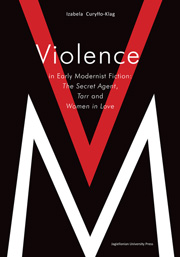Book contents
- Frontmatter
- Contents
- Acknowledgements
- Introduction
- CHAPTER I Modernist Consciousness of Crisis and the Emergent Violence Mythos
- CHAPTER II Ticking Towards Disaster—Violence as “The Enemy Within” in Conrad's The Secret Agent
- CHAPTER III “All Personality Was Catching”—Mimetic Rivalry and the Contagion of Violence in Tarr
- CHAPTER IV Humanity in a Cul-de-sac: Women in Love as an Epic of Sacrificial Crisis
- Conclusion
- Bibliography
CHAPTER II - Ticking Towards Disaster—Violence as “The Enemy Within” in Conrad's The Secret Agent
Published online by Cambridge University Press: 05 September 2014
- Frontmatter
- Contents
- Acknowledgements
- Introduction
- CHAPTER I Modernist Consciousness of Crisis and the Emergent Violence Mythos
- CHAPTER II Ticking Towards Disaster—Violence as “The Enemy Within” in Conrad's The Secret Agent
- CHAPTER III “All Personality Was Catching”—Mimetic Rivalry and the Contagion of Violence in Tarr
- CHAPTER IV Humanity in a Cul-de-sac: Women in Love as an Epic of Sacrificial Crisis
- Conclusion
- Bibliography
Summary
In England the ground appears solid and the structure of State firm, to a superficial observer. But if he lay his ear to the ground … and if he examine the walls closer, he will see that underneath the varnish and gold plating, dangerous cracks extend from top to bottom.
Max Nordau, The Conventional Lies of Our Civilisation“An explosion is the most lasting thing in the universe. It leaves disorder, remembrance, room to move, a clear space,” declares Conrad in one of his letters. At the turn of the twentieth century, when these words were written, explosions had a certain allure: their energy and potential for energising appealed to the human need for an instant change, a radical break with the past, a complete redefinition of reality. The new was to arrive with a cathartic big bang—a starting point for a transvaluation of all values that, according to the epoch's key philosopher, Nietzsche, could finally redeem the erring human race. History proved otherwise: blasts, detonations and other destructive outbursts quickly became modernity's gloomy emblems, though they were rarely followed by the positive developments they had initially promised. Conrad must have had a premonition of this when in 1907, while working on The Secret Agent, he made an explosion the main event of the plot and peopled his book with characters who carry inflammable ideas.
- Type
- Chapter
- Information
- Violence in Early Modernist FictionThe Secret Agent, Tarr and Women in Love, pp. 31 - 57Publisher: Jagiellonian University PressPrint publication year: 2011



